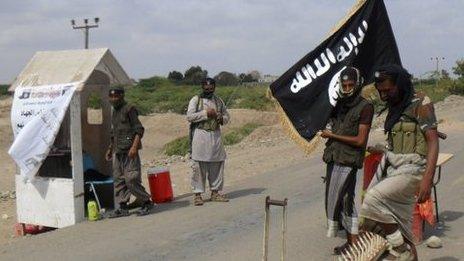Al-Qaeda Yemen plane bomb plot foiled by 'insider'
- Published
White House counter-terrorism advisor John Brennan has said that the bomb was never an active threat.
A plot by al-Qaeda in the Arabian Peninsula to attack a US-bound plane using an updated "underwear bomb" was foiled by an insider infiltrating a terror cell, US officials say.
The seized device is being examined by the FBI in Quantico, Virginia, while the source is said to have left Yemen.
The White House says the bomb was never an "active threat".
Meanwhile, a senior US congressman has linked the plot to an al-Qaeda leader killed in Yemen on Sunday.
Fahd al-Quso, a senior figure in Yemen-based al-Qaeda in the Arabian Peninsula (AQAP) was killed by a drone strike.
In a separate development on Tuesday a Pentagon spokesman said the US had restarted military training with security forces in Yemen, which had been put on hold because of political unrest.
"We have begun to reintroduce small numbers of trainers into Yemen," Captain John Kirby told reporters, adding that they had been sent for "routine military-to-military co-operation".
Saudi tip
Speaking on Tuesday, White House counter-terrorism chief John Brennan would not be drawn on the nature of the operation to seize the device, instead describing the aim of the FBI investigation into the device.
"Now we're trying to make sure that we take the measures that we need to prevent any other type of IED [improvised explosive device], similarly constructed, from getting through security procedures," Mr Brennan said.
Without giving specifics, the US says multiple overseas intelligence agencies were involved in the operation to seize the device.
Reports did not detail which foreign agencies the insider was working with.
However, reports have linked the device to a Saudi-born al-Qaeda bomb-maker, Ibrahim al-Asiri, previously named as a key figure in the 2009 underwear bomb plot.
A US intelligence source told CNN the latest plan was thwarted two weeks ago following a tip from Saudi Arabia, heightening suggestions that Saudi intelligence operatives could have been involved.
Senior Yemeni officials say the government in Sanaa has no information on this particular plot, Reuters news agency reported on Tuesday.
As details of the plot emerged in the US, officials said it appeared that AQAP leaders in Yemen had instructed a suicide bomber to board any flight of his choosing to the US with the bomb under his clothes.
However, he had been stopped before reaching an airport.
Reports say no target had been chosen and no plane tickets purchased by the time the alleged plot was foiled.
Christmas Day attack
Speaking late on Monday, Republican Congressman Peter King said late on Monday that the operation was linked to the strike that killed al-Quso.
"I was told by the White House that they are connected, that they are part of the same operation," he said.
A US Department of Justice video shows what would have happened if Umar Farouk Abdulmutallab's terror attack had succeeded
Al-Quso was a leader of AQAP based in Yemen, and the US offered a $5m (£3.1m) reward for information leading to his capture or death.
US officials told ABC News that that al-Quso was planning an attack similar to a failed 2009 attempt to blow up a passenger plane.
The alleged device seized from the Yemen cells shares some features with the bomb sewn into the underwear of would-be suicide bomber Umar Farouk Abdulmutallab during that attempt, officials said.
The Nigerian was arrested when his device failed to explode fully while on a plane bound for Detroit on Christmas Day 2009.
A US intelligence official said the latest device bore the "hallmarks" of the 2009 underwear bomb, which was built by the Saudi militant Ibrahim al-Asiri.
Reports said it was an improved model, with a more effective detonation system; it has no metal parts and probably would not have been detected by most airport security magnetometers.
It is not even clear if it would have been found by the body scanners that have been installed in some US airports after that attempted attack three years ago.
The US Transport Security Administration has sent reminders to some international airports and airlines that liquid explosives or regular explosives could be hidden inside people's bodies, clothes or in printer cartridges, the Associated Press reports.
- Published18 January 2012

- Published16 June 2015

- Published4 July 2014

- Published7 May 2012

- Published16 February 2012
